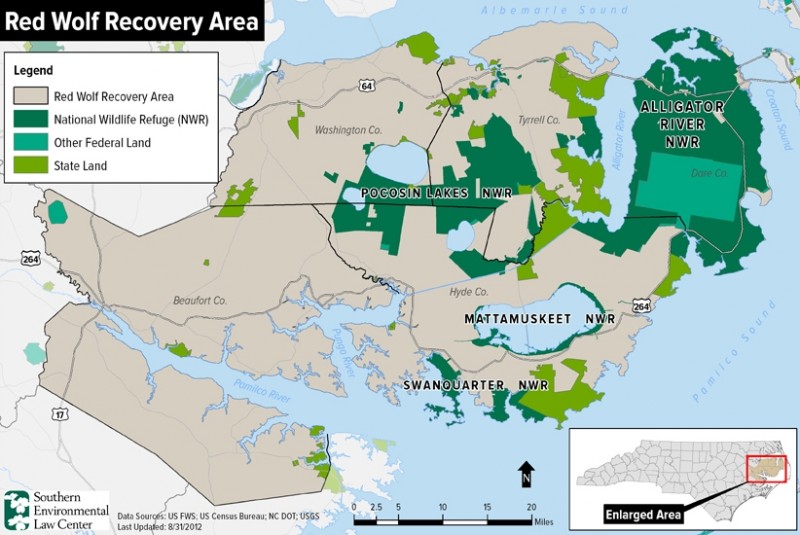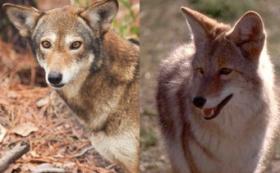As the director of the Red Wolf Coalition, Wheeler cares for these two captive red wolves at their enclosure just south of Columbia. She often brings groups of tourists here to see the mating pair and learn more about how the species behaves. “She’s certainly more active than he is, but just to watch and sit here quietly – the way they move here through their enclosure is so quiet - you can just imagine them in the wild, and how they move around undetected,” said Wheeler.
In 1987, the red wolf made history in eastern North Carolina, when four mating pairs were released into the Alligator River National Wildlife Refuge. It was the first species determined to be extinct in the wild to be reintroduced outside of captivity.
One hundred or so wild red wolves now roam across five counties in eastern North Carolina, including three wildlife refuges, a naval bombing range, and private farms. It’s an area larger than the state of Delaware.
The red wolves are top-level predators here on the isolated coastal plains, eating mostly rodents, white-tailed deer, raccoons, and wild turkey. And they are definitely stealthy – Kim Wheeler has been here nine years and only seen them twice in the wild, but she hears them quite a bit. “I love their howl,” she said. “And to know that that sound would have gone extinct had the U.S Fish And Wildlife Service not stepped in to do something to restore this animal. It’s kind of an amazing thing to stand there and hear that and know that could have been erased from this planet.”
Keeping the red wolf howling in the wild has not been cheap. The U.S. Fish and Wildlife Service has spent nearly $30 million since the start of the recovery program. For all of those 27 years it’s been a constant struggle to manage breeding and keep red wolves off of private lands.
Landowners have been skeptical of the recovery program almost from its inception. But lately, as both the wolf population and general anger with the federal government has grown, the situation has come to a head.
Landowners Speak Out
About 100 or so people crammed into the cafeteria at Mattamuskeet High School on a stretch of isolated highway in Hyde County - sitting around tables normally reserved for hungry teenagers.
They are here for a public comment session as part of the federal review that will determine the future of the Red Wolf Recovery Program. “I want the red wolf program done away with” said Wade Hubers, a local farmer. “I’m no biologist, but I know if you put ed wolves on the Refuge and there is no food supply, they are not going to stay there.”
Since the first wolves were introduced, roaming off of the refuge has been a problem. But another challenge is more recent: coyotes. As they have across the country, the coyote population in eastern North Carolina has exploded. Here, they have both fought with and bred with the red wolves.
Earlier this year, the Southern Environmental Law Center sued to make coyote hunting illegal in Hyde, Beaufort, Washington, Dare, and Tyrell – the five counties in which red wolves roam. Last May, Judge Terence Boyle issued an injunction on coyote hunting while the case is pending.
That further infuriated landowners. Many make the claim that there is no such thing as a pure red wolf. ”You know the red wolf can not be full-blooded,” said Lynn Clayton from Hyde County, stepping to the microphone with a grin. “He must have at least a little bit of Mexican blood in him - he won’t stay on his side of the border.” Many in the crowd applauded the insensitive comment, but not all of those who spoke were as outwardly prejudiced.
Roger Seale lives in Rocky Mount, but owns land in several areas, including one tract in Hyde County on which he hoped to cultivate wild turkey. By his estimate, he spent $8,000 a year over several years on food and clearing large trees and vegetation to try to build a wild turkey population he could hunt. “But when I started checking my trail cameras,” he explained, “I’d see turkey, I’d see turkey, and then I’d see wolf.”
Within about a year after he spotted the first red wolf on his trail camera, the turkeys were gone. He blames the red wolves. Seale says hunting in the area is depleted, forcing recreational hunters to go elsewhere and having a negative impact on an area with very little economic activity. “I don’t want any animal to go extinct, but I also don’t want the protection of an animal to affect the personal landowner,” Seale said.
The private firm leading the review of the Red Wolf Recovery Program will issue a report next month. The U.S. Fish and Wildlife Service will make a final decision on the future of the wild red wolf sometime early next year.
source




No comments:
Post a Comment